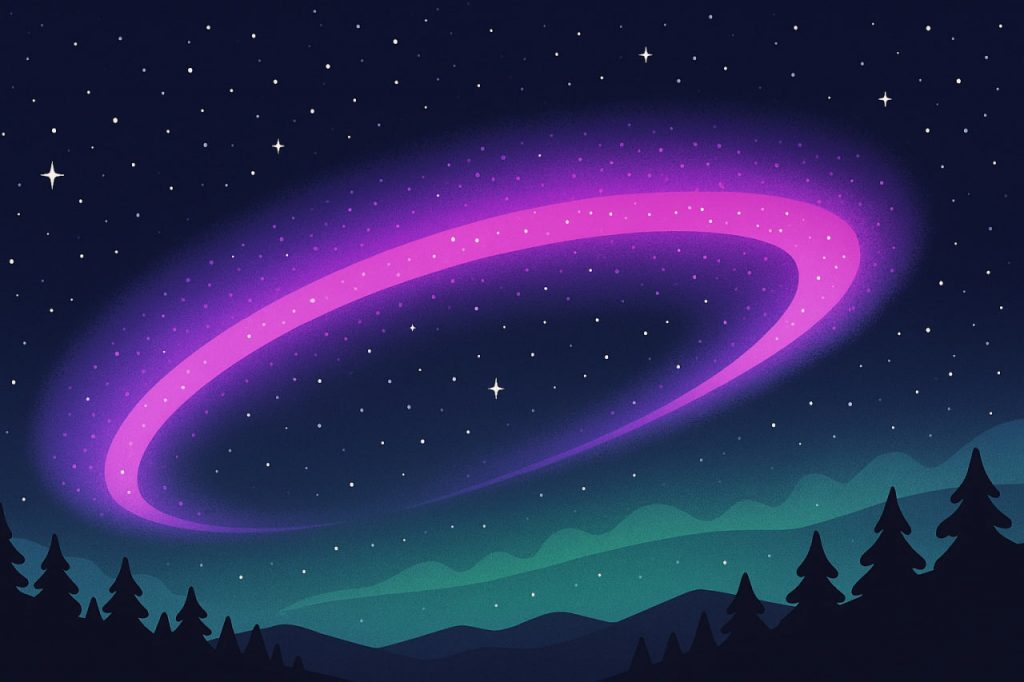In recent years, scientists and skywatchers have discovered a mysterious atmospheric phenomenon known as STEVE (Strong Thermal Emission Velocity Enhancement). At first mistaken for a type of aurora, STEVE appears as a narrow purple or pink arc stretching across the night sky. Unlike traditional auroras, it occurs at different altitudes and under unique conditions, making it an exciting subject for space and atmospheric science.
Discovery of STEVE
Although sightings of unusual glowing arcs in the sky were reported for centuries, the phenomenon was formally recognized in 2016. Amateur aurora photographers in Canada documented it and shared images with scientists, who confirmed that it was something different from known auroras. The name STEVE started as a joke among observers but was later adopted officially by the scientific community.
Characteristics of STEVE
STEVE usually appears as a thin, ribbon-like band of light, often purple, pink, or mauve in color. It can stretch thousands of kilometers across the sky, but only a few tens of kilometers wide. Unlike auroras, which dance and shift, STEVE remains relatively stable and linear.
How STEVE Forms
STEVE is not a typical aurora caused by charged particles from the Sun colliding with Earth’s atmosphere. Instead, it is linked to fast-moving ionized gases in the upper atmosphere, flowing at speeds of up to 6 km per second. These flows generate heat and create glowing emissions at unusual altitudes, different from those of normal auroras.
Differences from Auroras
While both STEVE and auroras are tied to geomagnetic activity, their mechanisms differ. Auroras form at higher latitudes and involve direct particle collisions. STEVE, on the other hand, can appear farther south, lasts shorter, and emits light through different processes, making it a distinct atmospheric event.
Scientific Importance
Studying STEVE provides insights into the complex interactions between Earth’s atmosphere and space weather. Understanding it helps scientists refine models of geomagnetic storms and ionospheric dynamics. It also shows how amateur observers and professional scientists can collaborate to make discoveries.
Conclusion
STEVE is a reminder that Earth’s atmosphere still holds mysteries waiting to be explored. Neither a true aurora nor a random glow, it represents a new frontier in space science and inspires both researchers and sky enthusiasts.
Interesting Facts
STEVE (short for Strong Thermal Emission Velocity Enhancement) is a mysterious atmospheric phenomenon that looks like a narrow ribbon of purple and white light, sometimes bordered by green picket-fence structures. First reported by amateur aurora watchers in Canada and later studied by NASA scientists, STEVE isn’t a typical aurora — it forms at lower latitudes and arises from a different physical process. Instead of being caused by charged solar particles, STEVE is linked to fast-moving ionized gases in the upper atmosphere, flowing at speeds over 6 km per second. Satellite observations show that these flows generate intense frictional heating, producing temperatures near 3,000°C, which makes the air glow in the visible spectrum. Interestingly, STEVE often appears during geomagnetic storms, yet it can occur without traditional auroral activity. This discovery has reshaped scientists’ understanding of how energy from the solar wind interacts with Earth’s atmosphere, revealing that our planet’s night sky still holds many surprises.
Glossary
- STEVE – Strong Thermal Emission Velocity Enhancement, a unique atmospheric glow.
- Aurora – natural light display in the sky caused by solar particles interacting with Earth’s atmosphere.
- Ionosphere – part of Earth’s upper atmosphere, ionized by solar radiation.
- Geomagnetic activity – disturbances in Earth’s magnetic field caused by solar wind.
- Space weather – environmental conditions in space influenced by the Sun.


